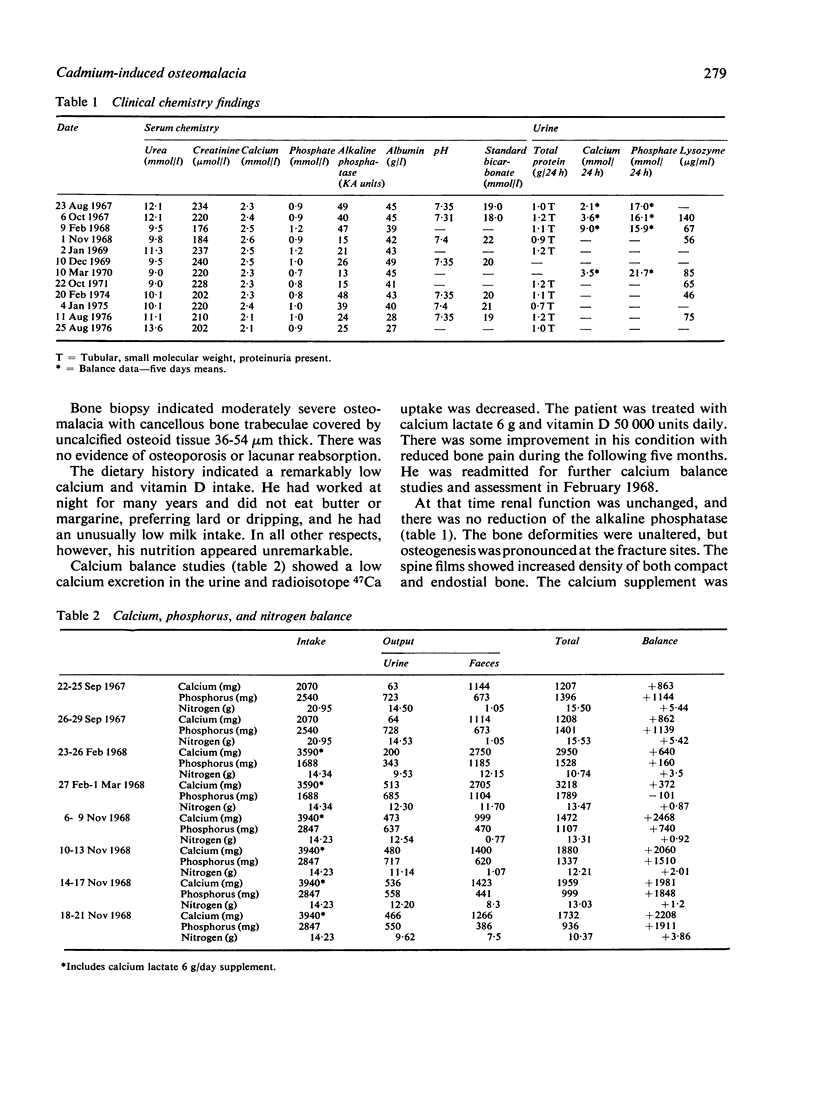Abstract
The detailed study of a battery plate maker, who had worked with cadmium for 36 years, showed that proteinuria, typical of renal tubular dysfunction, had been observed for 25 years and during the last 12 years of his life the patient had suffered increasing disability from gross bone disease. Several bone biopsies and detailed metabolic studies showed typical severe osteomalacia, which responded well initially to calcium and vitamin D treatment. Examination of the liver both in life and after death showed a gross excess of cadmium. This was also found in the kidneys after death. Previously unreported changes were present in the bones, especially the lumbar vertebrae which were probably more the result of gross bone deformity than cadmium deposition. The mechanism of development of the severe acquired Fanconi syndrome was thought to be a combination of dietary calcium and vitamin D deficiency and impaired calcium absorption from abnormal vitamin D synthesis, related to the cadmium deposition in the renal tubules, which also caused the defect in renal tubular reabsorption.
Full text
PDF






Images in this article
Selected References
These references are in PubMed. This may not be the complete list of references from this article.
- Adams R. G., Harrison J. F., Scott P. The development of cadmium-induced proteinuria, impaired renal function, and osteomalacia in alkaline battery workers. Q J Med. 1969 Oct;38(152):425–443. [PubMed] [Google Scholar]
- BONNELL J. A. Emphysema and proteinuria in men casting copper-cadmium alloys. Br J Ind Med. 1955 Jul;12(3):181–195. doi: 10.1136/oem.12.3.181. [DOI] [PMC free article] [PubMed] [Google Scholar]
- BONNELL J. A., KAZANTZIS G., KING E. A follow-up study of men exposed to cadmium oxide fume. Br J Ind Med. 1959 Apr;16(2):135–147. doi: 10.1136/oem.16.2.135. [DOI] [PMC free article] [PubMed] [Google Scholar]
- BUTLER E. A., FLYNN F. V. The proteinuria of renal tubular disorders. Lancet. 1958 Nov 8;2(7054):978–980. doi: 10.1016/s0140-6736(58)90473-2. [DOI] [PubMed] [Google Scholar]
- Curry A. S., Knott A. R. "Normal" levels of cadmium in human liver and kidney in England. Clin Chim Acta. 1970 Oct;30(1):115–118. doi: 10.1016/0009-8981(70)90199-3. [DOI] [PubMed] [Google Scholar]
- Harrison J. F., Lunt G. S., Scott P., Blainey J. D. Urinary lysozyme, ribonuclease, and low-molecular-weight protein in renal disease. Lancet. 1968 Feb 24;1(7539):371–375. doi: 10.1016/s0140-6736(68)91350-0. [DOI] [PubMed] [Google Scholar]
- Harvey T. C., Thomas B. J., McLellan J. S., Fremlin J. H. Measurement of liver-cadmium concentrations in patients and industrial workers by neutron-activation analysis. Lancet. 1975 Jun 7;1(7919):1269–1272. doi: 10.1016/s0140-6736(75)92552-0. [DOI] [PubMed] [Google Scholar]
- KAZANTZIS G., FLYNN F. V., SPOWAGE J. S., TROTT D. G. Renal tubular malfunction and pulmonary emphysema in cadmium pigment workers. Q J Med. 1963 Apr;32:165–192. [PubMed] [Google Scholar]
- Lewis G. P., Coughlin L. L., Jusko W. J., Hartz S. Contribution of cigarette smoking to cadmium accumulation in man. Lancet. 1972 Feb 5;1(7745):291–292. doi: 10.1016/s0140-6736(72)90294-2. [DOI] [PubMed] [Google Scholar]
- McLellan J. S., Thomas B. J., Fremlin J. H., Harvey T. C. Cadmium-its in vivo detection in man. Phys Med Biol. 1975 Jan;20(1):88–95. doi: 10.1088/0031-9155/20/1/008. [DOI] [PubMed] [Google Scholar]
- Roels H., Bernard A., Buchet J. P., Goret A., Lauwerys R., Chettle D. R., Harvey T. C., Haddad I. A. Critical concentration of cadmium in renal cortex and urine. Lancet. 1979 Jan 27;1(8109):221–221. doi: 10.1016/s0140-6736(79)90630-5. [DOI] [PubMed] [Google Scholar]
- STANBURY S. W., LUMB G. A. Metabolic studies of renal osteodystrophy. I. Calcium, phosphorus and nitrogen metabolism in rickets, osteomalacia and hyperparathyroidism complicating chronic uremia and in the osteomalacia of the adult Fanconi syndrome. Medicine (Baltimore) 1962 Feb;41:1–34. [PubMed] [Google Scholar]
- Shain S. A. In vitro metabolism of 25-hydroxycholecalciferol by chick intestinal and renal cell preparations. Identification of a metabolic product as 1,25-dihydroxycholecalciferol and delineation of its metabolic fate in intestinal cells. J Biol Chem. 1972 Jul 10;247(13):4393–4403. [PubMed] [Google Scholar]
- Vernon-Roberts B., Pirie C. J. Healing trabecular microfractures in the bodies of lumbar vertebrae. Ann Rheum Dis. 1973 Sep;32(5):406–412. doi: 10.1136/ard.32.5.406. [DOI] [PMC free article] [PubMed] [Google Scholar]







